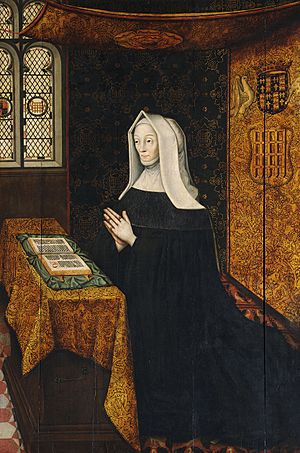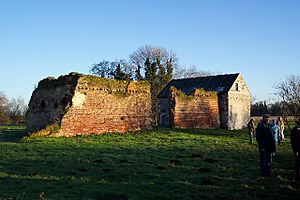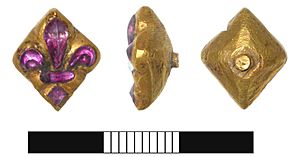Woking Palace facts for kids
Woking Palace was once a grand manor house and royal home located near Woking, in Surrey, England. It was a special place because it belonged to the King or Queen of England.
The palace was given to many different people by the Crown (the King or Queen) over the years. In 1466, Lady Margaret Beaufort, who was the mother of King Henry VII of England, and her husband, Sir Henry Stafford, were given the manor.
Contents
A Royal Home: The History of Woking Palace
The first time Woking Palace was mentioned in historical records was in 1272. It became a very important place for the royal family. Lady Margaret Beaufort, her son Henry VII of England, and her grandson Henry VIII all used it.
King Henry VII turned the manor house into a palace in 1503. Later, his son Henry VIII and Queen Elizabeth I also made changes to it. Today, you can still see the old ruins of the palace buildings in a grassy area near water.
Lady Margaret Beaufort was a very influential woman. She was known for being smart and making good decisions, especially with her marriages. She played a big part in making sure her son, Henry VII, became the first king of the Tudor dynasty. She also started important schools like Christ's College, Cambridge and St John's College, Cambridge.
What Did Woking Palace Look Like?
Woking Palace was surrounded by a moat, which is a deep, wide ditch filled with water for protection. The palace had four main areas. These included a medieval barrel vault (a type of arched ceiling) and the King's Hall, which Henry VII built in 1508. There was also the King's Garden, which was once a formal kitchen garden for growing food, but is now a wilder meadow. The Copse area used to be an orchard and had two large fish ponds. The River Wey flowed along one side, completing the palace's watery defenses.
Today, the Woking Borough Council looks after the ruins. They have put a protective roof over the barrel vault and made repairs to the remaining Tudor walls to keep them safe.
King Henry VIII's Visits
King Henry VIII often visited Woking Palace. During his time, the palace was regularly looked after and improved. He added a new dock by the River Wey and even two new bowling alleys for fun! Workers also replaced bridge planks, changed room layouts, plastered and painted walls, fixed windows, and repaired roofs and fireplaces.
King James I and Sir Edward Zouch
King James VI and I visited Woking Palace in March 1606. During one of his visits, a false rumor spread in London that he had been attacked. Luckily, the King was fine and quickly returned to London.
In 1609, King James made Sir Edward Zouch the manager of Woking Palace and the park. Sir Edward asked for repairs to be made, including cleaning the moat and building a new bridge. This new bridge would make the King's garden more private. King James enjoyed visiting Woking often, especially in March.
Sir Edward Zouch was given the estate in 1620. It is thought that he might have used materials from the palace to build his own new house nearby. Sir Edward was also involved in setting up early English settlements in America, like the Plymouth Colony. He was given the palace for a yearly rent and had the special duty of serving the King the first dish at a feast on St James's Day.
King James I sometimes visited Sir Edward Zouch at Woking for parties and hunting trips. He enjoyed hunting the large deer in Zouch's park. By the time King Charles II was on the throne (1660-1685), Woking Palace seemed to have been left empty and was mostly in ruins.
Archaeological Discoveries at Woking Palace
Archaeologists have found many interesting objects at Woking Palace. These finds are recorded by the Portable Antiquities Scheme. Some valuable items, like those made of precious metals, are protected by the Treasure Act 1996. This law makes sure that important historical finds are declared and kept safe.
Some of the cool things found at the site include:
- A gold brooch or pin from between 1400 and 1550. It has a fleur-de-lis design made from a purple stone called amethyst.
- A copper object from around 1750-1900 that might have been a lid. It has a picture of a horse on it.
Protecting Woking Palace for the Future
Experts say that Woking Palace is a very important historical site. It has a lot of archaeological potential, meaning there could be many more discoveries to be made, especially in the water-filled moats. The site is considered very valuable for its history, architecture, and archaeology.
Woking Palace is officially protected as a Scheduled Ancient Monument. This means it is a nationally important historical site. It is owned by the Woking Borough Council, who work to preserve it for everyone to learn from and enjoy.
Images for kids







